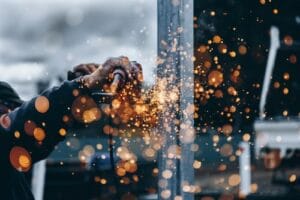The Cost of Custom Dampers
May 27, 2020What influences the cost of designing, manufacturing, and installing a custom damper from Kelair?
Many factors determine the cost associated with the design and build of custom dampers. Let’s explore some of the influencing variables that determine the cost.
Questions about pricing for your industrial damper? Contact a member of the Kelair Products, Inc. team.
Materials Used in Dampers
 The type of material used to construct a damper can be a large differentiator in the cost of dampers. Why? Well, different materials have different costs. For example, stainless steel costs more than carbon steel (as a result of a different or more involved manufacturing process), so if the application or process where your damper is used contains corrosive gas or high heat (e.g. within ), stainless steel will be the recommended material for optimal damper life. As a result, the cost of a damper using stainless steel will likely be higher than that of a carbon steel damper.
The type of material used to construct a damper can be a large differentiator in the cost of dampers. Why? Well, different materials have different costs. For example, stainless steel costs more than carbon steel (as a result of a different or more involved manufacturing process), so if the application or process where your damper is used contains corrosive gas or high heat (e.g. within ), stainless steel will be the recommended material for optimal damper life. As a result, the cost of a damper using stainless steel will likely be higher than that of a carbon steel damper.
Keep in mind that metal prices do change frequently (fluctuate based on demand and availability) which can affect the cost of building a custom damper.
Damper Size
The size of a damper does play an important role in the cost of manufacturing. As you may imagine, dampers that are larger in size require more material (e.g. stainless steel or carbon steel) and the more labor is required to construct and weld these custom products.
In addition to the physical size (footprint), industrial dampers have many parts that can influence the cost , though they are not typically considered significant. Many of Kelair’s clients, in fact, consider these costs neglible when planning for the cost of their damper.
Kelair works directly with its clients during the quoting process, helping them purchase exactly what they need to ensure the optimal lifespan of their process damper.
Environmental Factors
How dampers are ultimately used plays a major role in the cost. If the industry or process is considered to be “high heat”, deals with corrosive elements, or is particulate dense, the cost of the damper may be higher than those manufactured for non-corrosive, ambient processes. Dampers designed for use in harsh conditions typically need to be built with stainless steel which raises the cost to buil and optimize the damper life.
How and where custom dampers are used also plays a role in cost. The largest ifferentiation in applications that Kelair clients see in costs are between HVAC (most often light-duty dampers for heating, air conditioning and ventilation) and industrial process applications (medium-heavy duty dampers to control process air that is cool, warm, high temperature, dirty or topic).
Damper Actuation
Actuators, which are responsible for controlling and moving mechanisms within the damper, are important factors to consider when planning for the cost of building a damper.
There are three main actuation options when selecting the type of actuation used in a damper: electric, pneumatic, and manual. Electric and pneumatic actuation are more costly than a manual handwheel, but they require no physical labor. Plus, they can typically open/close the damper more quickly and require little to no maintenance.
Testing and Inspection
 Kelair offers on-site inspections of dampers that are currently in place or new applications.
Kelair offers on-site inspections of dampers that are currently in place or new applications.
Dampers are sometimes an item that gets pushed to the end of the inspection list as long as they work, until they don’t. By inviting Kelair to inspect a damper, we can identify maintenance items that will save you the replacement of the damper in the long-run or we can prepare the customer for a replacement with an application-correct damper that will last and require minimal to no maintenance.
The cost of inspections are $995 per day and if the customer decides to purchase a damper(s), this damper(s) inspection fee is credited or waived. Learn more about the Kelair process for inspecting dampers.
Installation
When purchasing any damper, it’s important to be conscious of the installation costs which in some instances can be equal to, if not more than, the cost of the damper.
If the damper is replacing an in-place damper, it is also important to take into budgeting-consideration the cost of the tear-down prior to replacement.
Questions about the cost of manufacturing and installing a damper for your facility?
Get in touch with a Kelair Products, Inc. representative today.

